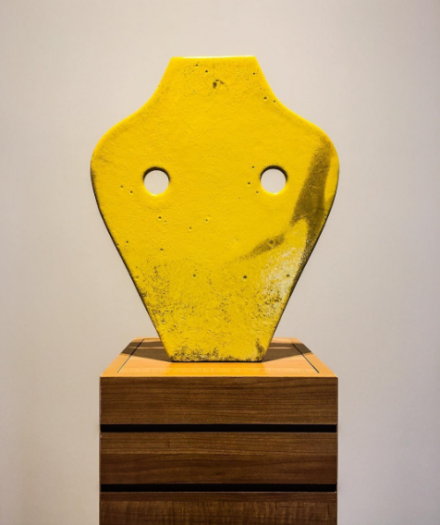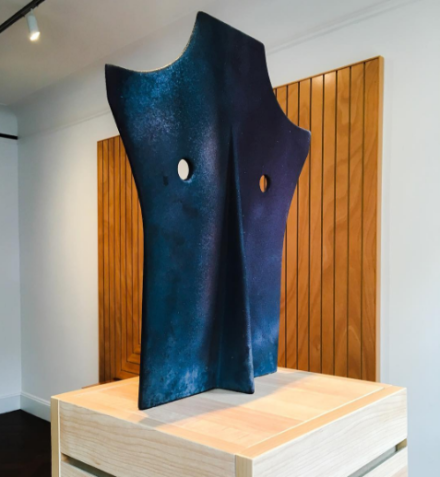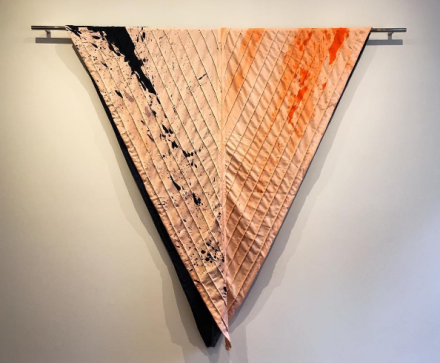
Pia Camil, Bust Mask Sulphur (2016), via Art Observed
Taking over the townhouse exhibition space of Blum & Poe on Manhattan’s Upper East Side, Pia Camil is currently showing a series of new sculptural works, with show titled Slats, skins and shop fittings. Mining the vocabulary and iconography of commodity production and the performance of capitalism within social interactions or group participation, the exhibition pays express homage to the Copper paintings of Frank Stella, while suspending the post-war master’s work in a broader hierarchy of industrial manufacturing and material sources.

Pia Camil, Slats, skins and shop fittings (Installation View), via Art Observed
Much in the manner that Stella’s early works in this series explored the painting as an object, or a product of a mechanical, repetitive mode of industrial technique, Camil dives into his work from the vantage point of profit-motive. Her works are produced in a similar manner, yet realized with plywood instead of copper, playing on the affordability of the material and its subsequent gestural capacities when hung in the same art historical and production context as Stella’s originals. In turn, these formal references to Stella’s work, and the post-war minimalists more broadly, is turned again towards the commercial when she hangs her own fabric works, textile cloaks sourced from fabric factory castoff materials and dyed by chance operations.

Pia Camil, Bust Mask Charcoal (2016), via Art Observed
By this series of operations, Camil operates on the body of modern art by way of its own technical processes, turning the final product into a sort of display for her “merchandise.” The resemblance of the works on view to shop displays or clothing racks is intentional, with Camil utilizing their respective implications to underscore the contemporary work’s suspension between historical referentiality and commodity status. It’s a coy turn on the critique of the gallery space, pushing beyond outlining the pervasive effects of capital on the field of art production to explore its function in the discourse and practice itself. Camil understands the relationship of the work to its own history, and to the act of inclusion. Her works reproduce the conditions of the historical critique at a fraction of the production cost for Stella’s work, underscoring raw material and financial underpinnings of these pieces, while showing the necessity of the work to include itself within the discourse to find inclusion within the gallery environment, to even begin to qualify as an art object/art commodity.

Pia Camil, Valparaiso Green Cloak II (2016), via Art Observed
This work is echoed in her Bust Masks, also on view in the gallery, which draw equally from Carl Jung’s concept of the persona, the mask worn by an individual in society, and from the structure of department store jewelry displays. Here, Camil’s interest in the intersection of histories and discourses doubles over into the notion of identity itself, the act of consumption as identification and performance in modern society. Her busts are bound by their relation to products themselves, presenting a raw material good for the viewer to use in the construction of their own personal masks.

Pia Camil, Slats, skins and shop fittings (Installation View), via Art Observed
Camil’s work is notably subtle in its exploration and subversion of commercial, art historical and psychological formats, and her masterful blending of each underscores the terrain of modern production and consumption. Rather than berate the system in which her work exists, Camil seems content to explore its symptomatic collisions of meaning and construction, a space where the viewer plays a distinct role in the exchange.
Pia Camil, Telluride Tunic (2015), via Art Observed
— D. Creahan
Read more:
Pia Camil at Blum and Poe [Exhibition Site]




